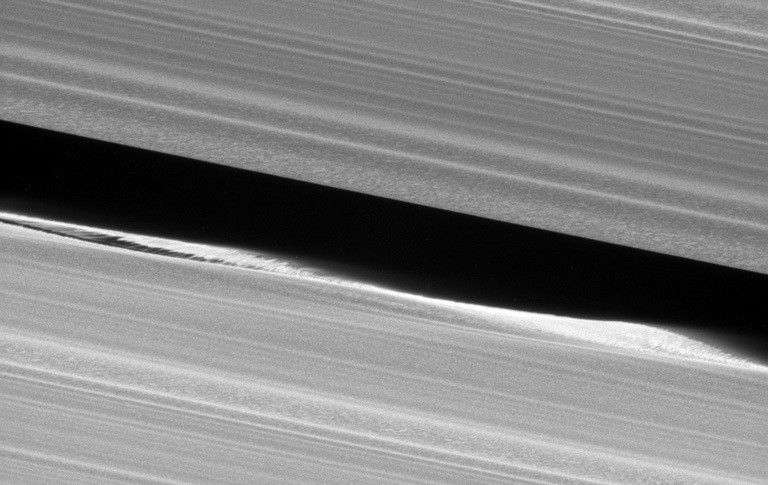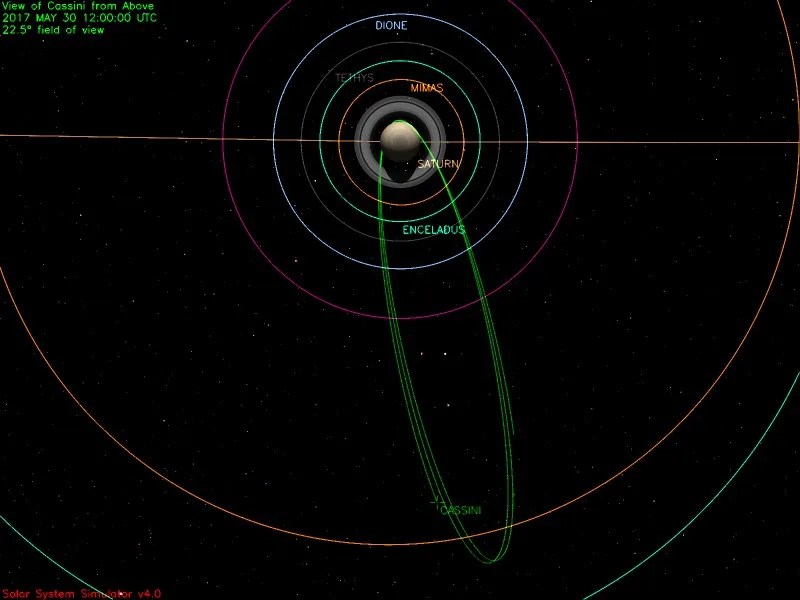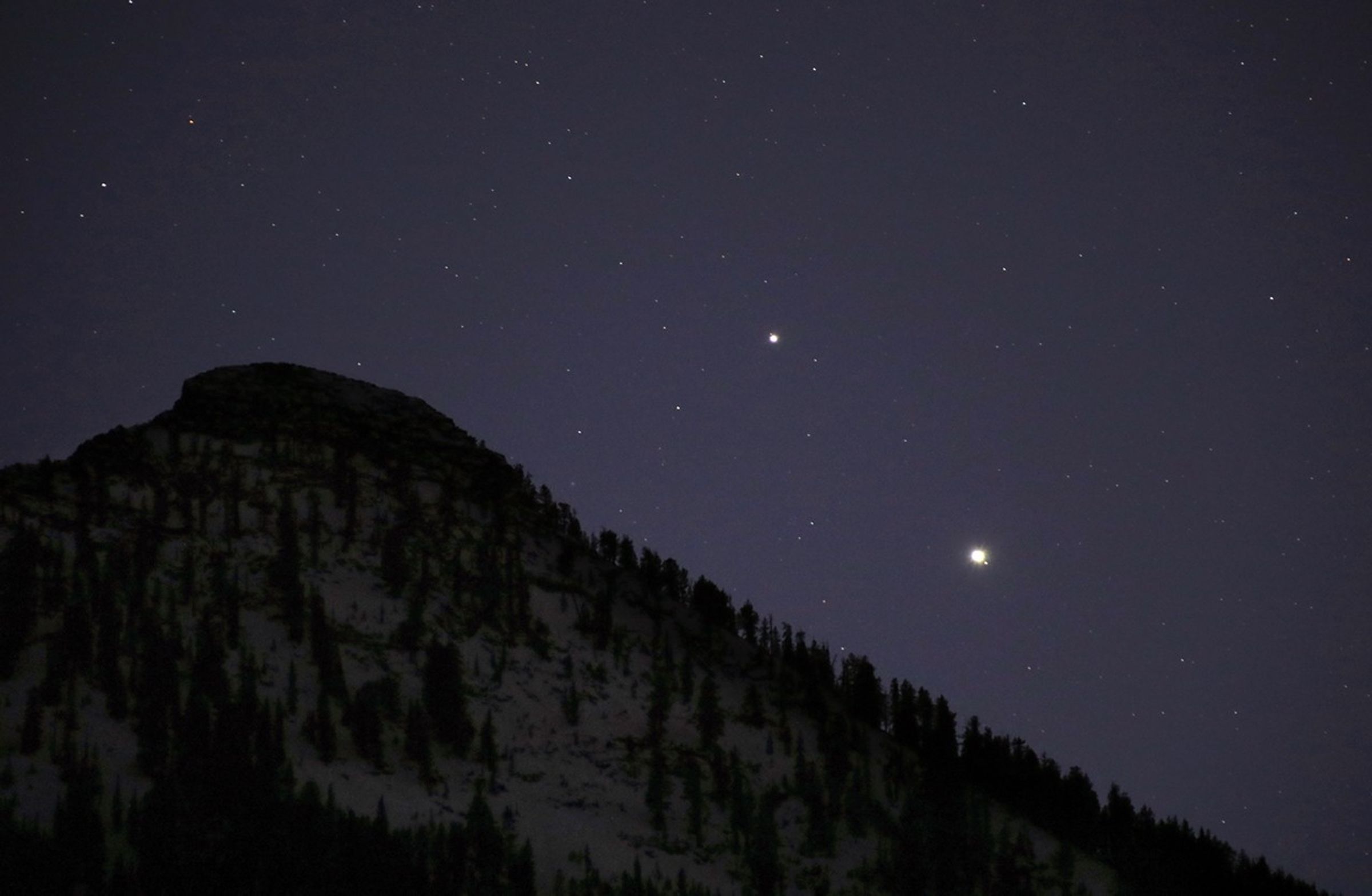
For the past seven years, the Cassini spacecraft has been orbiting Saturn in the Cassini Solstice Mission. An ambitious goal of this mission phase was to continue operating an aging spacecraft while it reported on the gas giant's slowly changing seasons. Since each of Saturn's trips around the Sun takes 29.5 Earth-years, that's how often the northern-hemisphere summer solstice occurs. And since Cassini has proven to be such a robust and well-operated spacecraft, that goal has now been reached. Saturn’s summer solstice occurred on May 24.
It was early summer there a Saturn-year ago when the Voyager-1 and Voyager-2 spacecraft flew rapidly through the Saturn system in 1980 and 1981. In doing so, they raised some tough questions about that system, many of which have now been addressed. Cassini's success in viewing the start of northern Saturn summer makes for a useful comparison of scientific results between the Voyager and Cassini missions.
Wednesday, May 24 (DOY 144)
Cassini made its closest pass by Saturn's moon Titan for the current orbit, while the Radar instrument finished up a two-hour altimetry observation using the high-gain antenna dish, measuring the height of surface features on the planet-like moon. Cassini then turned to point its Optical Remote-Sensing (ORS) instruments to Titan, where they spent the next 18.7 hours examining Titan's surface and dense atmosphere at wavelengths spanning from the far-infrared to the visible to the ultraviolet.
Saturn solstice occurred today. It is now winter in the south and summer in the north of the ringed giant, as well as on Titan, Enceladus, and Saturn's other moons. This article elaborates on the milestone:
/news/13065/cassini-looks-on-as-solstice-arrives-at-saturn
.
Thursday, May 25 (DOY 145)
Cassini returned to apoapsis today, the high point in its orbit of Saturn. Beginning to coast inbound again marked the start of its orbit #276. At the same time, the S100 command sequence, which had been uplinked the previous week, began its seven weeks of control over the spacecraft's activities.
First up in S100, the Imaging Science Subsystem (ISS) targeted Saturn's rings for 9.7 hours while they were sunlit at phase angles near 140 degrees. This is a good condition for observing the fainter, less optically thick components of Saturn's rings. The Composite Infrared Spectrometer (CIRS), the Ultraviolet Imaging Spectrograph (UVIS) and the Visible and Infrared Mapping Spectrometer (VIMS) all participated.
Friday, May 26 (DOY 146)
VIMS and UVIS tracked the bright star Sirius (Alpha Canis Majoris) for 2.4 hours to watch it disappear behind Saturn's southern limb. The stellar-occultation observation probed Saturn's southern polar atmosphere simultaneously at near-infrared and ultraviolet wavelengths.
Next, CIRS began staring at the sunlit side of Saturn's dense B ring for 13.3 hours to determine its emissivity at thermal-infrared wavelengths, obtaining clues to the composition and structure of this optically thick region. VIMS rode along.
Saturday, May 27 (DOY 147)
UVIS joined in for the second half of the CIRS B-ring observation that began on the previous day. Next, UVIS trained on the star Epsilon Canis Majoris, and tracked its egress from occultation behind Saturn's mid-C ring, going all the way out beyond the F ring. CIRS rode along for this 6.2-hour observation.
Sunday, May 28 (DOY 148)
Today, Cassini made its sixth high-speed passage through the space between the rings and planet. This time, it came close enough to the innermost ring, the D ring, that its in-situ instruments were able to directly sense particles in that ring. As in the first ring-plane crossing, the High Gain Antenna (HGA) was oriented into the oncoming dust direction in order to shield the instruments and engineering systems. During the six-minute period nearest the D ring, the Radio and Plasma Wave Science (RPWS) instrument recorded impacts of ring particles on the spacecraft, which are detectable to RPWS by the plasma clouds they generate when they hit.
Just before speeding southbound past Saturn's equator and prior to the HGA shielding turn, Cassini's Radar instrument carried out a first-ever observation of rings using the Synthetic-Aperture Radar (SAR) imaging technique. Scanning from the outer edge of the A ring inward through the C ring, the resulting imaging resolutions are expected to range from 4 kilometers down to 100 meters. They are sensitive to centimeter-scale ring particles and larger, and so the results will allow ring scientists to study a different portion of the ring particles' size distribution.
Also around the ring-plane crossing, the ISS led the other Optical Remote-sensing instruments for ring observations making the best use of the opportunity to observe Saturn's rings at close range, including the sunlit side and the unlit side, and even watched another stellar occultation. In all, these instruments collected data for 14.6 hours today, including some of the highest resolution ring images ever obtained.
Next came an 8.5-hour Radio Science ring occultation experiment, which involved four DSN stations and two ESA ground stations, spanning three continents, as they observed Cassini's radio transmitters pass behind Saturn's rings.
Monday, May 29 (DOY 149)
ISS led the other ORS instruments today in a 7.1-hour observation of the icy plume that is constantly coming from Saturn's small active moon Enceladus. Part-way through this observation, UVIS and CIRS turned and observed a 4.2-hour stellar ring occultation, and ISS, CIRS, and VIMS took 90 minutes to spend on a routine Titan monitoring observation.
An extraordinary view of a section of Saturn's rings was the featured image today:
.
Tuesday, May 30 (DOY 150)
Today, Cassini made its final observation of Saturn's large, two-tone moon Iapetus. The ISS activity lasted 2.8 hours, and included participation from the other ORS instruments. When this was done, UVIS watched for one hour as the star Sigma Orionis passed behind the middle of Enceladus, so the instrument could look for any gas at low latitudes near that moon; ISS, CIRS, and VIMS rode along.
Capping off another busy week, ISS led UVIS and VIMS in a 17.4-hour observation of Saturn's small, irregular moon Bebhionn. As described in the May 3 report, this is one of the few objects orbiting Saturn which might have a binary or contact-binary nature.
This summary of an article in the journal Icarus describes a possible history for Enceladus:
/news/13067/cassini-finds-saturn-moon-may-have-tipped-over
.
The DSN communicated with and tracked Cassini on 11 occasions this week, using stations in California, Spain, and Australia; the European Space Agency supported twice, using their stations in Australia and Argentina. A total of 118 individual commands were uplinked, and about 2,240 megabytes of science and engineering telemetry data were downlinked and captured at rates as high as 142,201 bits per second.
Wrap up:
Cassini is executing its set of 22 Grand Finale Proximal orbits, which have a period of 6.4 days, in a plane inclined 62.4 degrees from the planet's equatorial plane. Each orbit stretches out to an apoapsis altitude of about 1,272,000 km from Saturn, where the spacecraft's planet-relative speed is around 6,000 km/hr. At periapsis, the distance shrinks to about 2,500 km above Saturn's visible atmosphere (by comparison, Saturn is about 120,660 km in diameter), and the speed is around 123,000 km/hr.
The most recent spacecraft tracking and telemetry data were obtained on May 31 using the 70-meter diameter DSN station in California. The spacecraft continues to be in an excellent state of health with all of its subsystems operating normally except for the instrument issues described at
http://saturn.jpl.nasa.gov/anomalies
.
The countdown clock in Mission Control shows 107 days until the end of the Mission.
------------------------
This page offers all the details of the Mission's ending: <https://saturn.jpl.nasa.gov/mission/grand-finale/overview/>
------------------------
Milestones spanning the whole orbital tour are listed here:
<https://saturn.jpl.nasa.gov/mission/saturn-tour/tour-dates/>
------------------------
Information on the present position and speed of the Cassini spacecraft may be found on the "Present Position" page at:
<https://saturn.jpl.nasa.gov/mission/saturn-tour/where-is-cassini-now/>
------------------------
To unsubscribe from Cassini Spacecraft Updates or to subscribe with a different email address, visit:
<http://saturn.jpl.nasa.gov/news/mailinglistsignup/>
------------------------
For comments and questions, please contact Cassini Public Engagement at:
<http://saturn.jpl.nasa.gov/feedback/>
------------------------
This illustration shows Cassini's path up to mid-day May 30, when the spacecraft was climbing outbound from its most recent close encounter with Saturn.



































